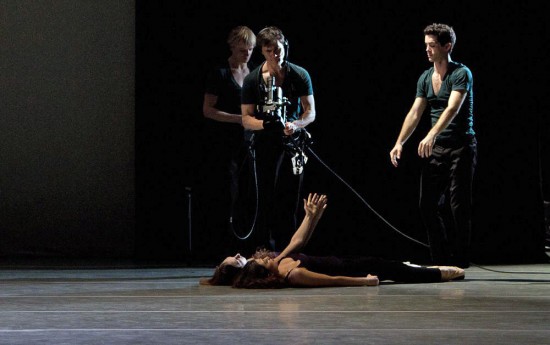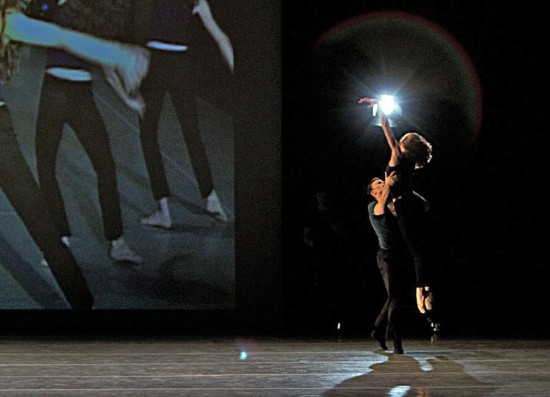The audience mills about at intermission, greeting acquaintances, texting those not present, nibbling on chocolates and waiting for the lights to go down for the next act. Slowly, a murmur seeps through the crowd, and chatter begins to dissipate. On stage, a huge projection screen – its contents faint under the bright house lights – shows a single dancer, wandering forward with a curious gaze. Her surroundings appear to be a theater, and the realization quickly spreads that it’s this very space, now! She’s here, with us! Necks crane, a few fingers point, and sure enough, the black-clad woman is spotted walking up the aisle left of the seats, preceded by a cameraman. She continues, taking a path through the doors and out of view into the lobby, where she is met by a male partner. All eyes return to the screen to watch their vestibule duet as the lights finally dim.

Deciding What to Watch
With this unorthodox opening, Benjamin Millepied introduces a ballet that continues to pique our media-savvy senses throughout its duration. His world premiere piece for Pennsylvania Ballet, This Part in Darkness, intertwines live video and dance in an exciting way that puts the viewer in an entirely new position. Does our focus belong on the the cameraman (principal dancer Alexander Iziliaev), carefully tiptoeing his way back and forth through the whirling choreography? Or the video he’s capturing, projected 40 feet high in glowing fidelity? And what about the dancers themselves, on stage in front of us, ostensibly the reason we’ve come to this theater, on this date, at this exact time?
At it’s best, the orchestration allows the viewer to pull back and absorb all parts at once, the brain slightly hypnotized by the complexity of patterns. With pacing that matches the aggressive rhythms of the score (Pulitzer Prize-winning composer David Lang’s Pierced), a line of men move from left to right in front of their video selves, who appear on screen to be travelling the exact opposite direction as the videographer points the lens toward the audience from behind. An overhead camera projects an Esther Williams-like view from above to create a mirror effect as we watch performers bob and weave in a circle from the front and the top at the very same time.
Multiple Media Streams
It’s similar to the way many now follow sports, entertainment or news event: TV in the background, iPad or mobile app showing up-to-the-minute stats and Twitter or Facebook providing individual commentary. We can observe from afar, or dive in to the thick of the action, zeroing in on one stream to examine details, like a close-up of two dancers’ hands creeping along a backstage brick wall, reaching out and recoiling from one another like animals doing a mating dance. This gripping scene diverts attention from the performers in front, but when the view is transferred back, the realization hits that the dancers on stage are interpreting the same back-and-forth routine, albeit in more volatile, full-body form.

No built-in pauses materialize during the fast-paced, turbulent choreography, no stops that solicit the often rote, mid-scene applause that characterizes much of traditional ballet. But technique is present, in some ways stronger than ever, as dancers keep aware that at any moment their feet or faces could be appearing, larger-than-life, on the big screen. There’s no time for reflection during this performance, which draws in the viewer much like a blockbuster movie, juxtaposing quick cuts between camera angles with dancers jumping and twirling before them. Fresh off work on the Academy Award-winning Black Swan, Millepied’s incorporation of Hollywood technique is no surprise, though he notes he’s been playing with the idea of a incorporating live video in a ballet for nearly nine years.
Groundbreaking Presentation
It’s a tricky act, and – like a great film – nearly impossible to absorb in one viewing. Fans of ballet’s fancy footwork and pinpoint pirouettes might bemoan the focus on these elements, though they do exist, tossed into the mix. By layering a dance performance with live video of the performance with on-stage capture of that video, Millepied has expanded the scope of ballet. The audience becomes an essential component, as these distinct pieces would not coalesce into a whole without the existence of the viewer. He hasn’t broken down the proverbial “fourth wall” so much as added a new one, a fifth dimension whose axis traces the course of art from the dancer’s body to the camera, through the lens to projection and then back to the body again through the eyes of the observer. Pennsylvania Ballet deserves kudos for executing and enabling this innovative achievement.
This Part in Darkness premiered April 14–17, 2011, at the Merriam Theater in Philadelphia